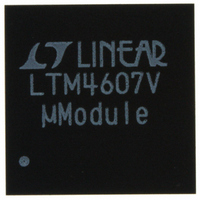LTM4607EV#PBF Linear Technology, LTM4607EV#PBF Datasheet - Page 9

LTM4607EV#PBF
Manufacturer Part Number
LTM4607EV#PBF
Description
IC BUCK/BOOST SYNC ADJ 5A 141LGA
Manufacturer
Linear Technology
Series
µModuler
Type
Point of Load (POL) Non-Isolatedr
Datasheet
1.LTM4607EVPBF.pdf
(26 pages)
Specifications of LTM4607EV#PBF
Design Resources
LTM4607 Spice Model
Output
0.8 ~ 24 V
Number Of Outputs
1
Power (watts)
120W
Mounting Type
Surface Mount
Voltage - Input
4.5 ~ 36 V
Package / Case
141-LGA
1st Output
0.8 ~ 24 VDC @ 5A
Size / Dimension
0.59" L x 0.59" W x 0.11" H (15mm x 15mm x 2.8mm)
Power (watts) - Rated
120W
Operating Temperature
-40°C ~ 85°C
Efficiency
98%
Lead Free Status / RoHS Status
Lead free / RoHS Compliant
3rd Output
-
2nd Output
-
Available stocks
Company
Part Number
Manufacturer
Quantity
Price
OPERATION
Power Module Description
The LTM4607 is a non-isolated buck-boost DC/DC power
supply. It can deliver a wide range output voltage from 0.8V
to 24V over a wide input range from 4.5V to 36V, by only
adding the sensing resistor, inductor and some external
input and output capacitors. It provides precisely regulated
output voltage programmable via one external resistor.
The typical application schematic is shown in Figure 18.
The LTM4607 has an integrated current mode buck-boost
controller, ultralow R
and integrated Schottky diodes. With current mode control
and internal feedback loop compensation, the LTM4607
module has sufficient stability margins and good transient
performance under a wide range of operating conditions
and with a wide range of output capacitors. The operating
frequency of the LTM4607 can be adjusted from 200kHz
to 400kHz by setting the voltage on the PLLFLTR pin.
APPLICATIONS INFORMATION
The typical LTM4607 application circuit is shown in
Figure 18. External component selection is primarily
determined by the maximum load current and output
voltage. Refer to Table 3 for specific external capacitor
requirements for a particular application.
Output Voltage Programming
The PWM controller has an internal 0.8V reference voltage.
As shown in the Block Diagram, a 100k internal feedback
resistor connects V
resistor R
the output voltage:
Table 1. R
V
V
R
R
OUT
OUT
V
FB
FB
OUT
= 0.8V •
FB
9.76k
Open
0.8V
FB
9V
Resistor (0.5%) vs Output Voltage
from the V
8.66k
115k
1.5V
10V
100k + R
OUT
DS(ON)
R
FB
FB
47.5k
7.15k
2.5V
and V
12V
pin to the SGND pin programs
FB
FETs with fast switching speed
FB
32.4k
5.62k
3.3V
15V
pins together. Adding a
19.1k
5.23k
16V
5V
15.4k
4.12k
20V
6V
3.4k
11k
24V
8V
Alternatively, its frequency can be synchronized by an in-
put clock signal from the PLLIN pin. The typical switching
frequency is 400kHz.
The Burst Mode and skip-cycle mode operations can be
enabled at light loads to improve efficiency, while the forced
continuous mode and discontinuous mode operations are
used for constant frequency applications. Foldback current
limiting is activated in an overcurrent condition as V
drops. Internal overvoltage and undervoltage compara-
tors pull the open-drain PGOOD output low if the output
feedback voltage exits the ±10% window around the
regulation point. Pulling the RUN pin below 1.6V forces
the controller into its shutdown state.
If an external bias supply is applied on the EXTV
an efficiency improvement will occur due to the reduced
power loss in the internal linear regulator. This is especially
true at the higher end of the input voltage range.
Operation Frequency Selection
The LTM4607 uses current mode control architecture at
constant switching frequency, which is determined by the
internal oscillator’s capacitor. This internal capacitor is
charged by a fixed current plus an additional current that
is proportional to the voltage applied to the PLLFLTR pin.
The PLLFLTR pin can be grounded to lower the frequency
to 200kHz or tied to 2.4V to yield approximately 400kHz.
When PLLFLTR is left open, the PLLFLTR pin goes low,
forcing the oscillator to its minimum frequency.
A graph for the voltage applied to the PLLFLTR pin vs
frequency is given in Figure 2. As the operating frequency
increases, the gate charge losses will be higher, thus the
efficiency is lower. The maximum switching frequency is
approximately 400kHz.
FREQUENCY SYNCHRONIZATION
The LTM4607 can also be synchronized to an external
source via the PLLIN pin instead of adjusting the voltage on
the PLLFLTR pin directly. The power module has a phase-
locked loop comprised of an internal voltage controlled
LTM4607
CC
pin, then
4607fb
9
FB















